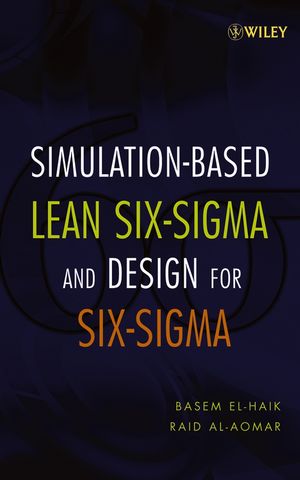Simulation-based Lean Six-Sigma and Design for Six-SigmaISBN: 978-0-471-69490-8
Hardcover
404 pages
September 2006
 This is a Print-on-Demand title. It will be printed specifically to fill your order. Please allow an additional 10-15 days delivery time. The book is not returnable.
|
||||||
PART I SIX-SIGMA FUNDAMENTALS.
1 Six-Sigma Fundamentals.
1.1 Introduction.
1.2 Quality and Six-Sigma Defined.
1.3 Introduction to Process Modeling.
1.4 Introduction to Business Process Management.
1.5 Measurement Systems Analysis.
1.6 Process Capability and Six-Sigma Process Performance.
1.7 Overview of Six-Sigma Improvement: DMAIC.
1.8 Six-Sigma Goes Upstream: Design for Six-Sigma.
1.9 Summary.
2 Lean Six-Sigma Fundamentals.
2.1 Introduction.
2.2 Lean Six-Sigma Approach.
2.3 LSS-Enhanced DMAIC.
2.4 Lean Manufacturing.
2.5 Value Stream Mapping.
2.6 Lean Techniques.
2.7 Summary.
3 Design for Six-Sigma Fundamentals.
3.1 Introduction.
3.2 Transaction-Based Design for Six-Sigma.
3.3 Service Design for Six-Sigma.
3.4 Service DFSS: The ICOV Process.
3.5 Service DFSS: The ICOV Process in Service Development.
3.6 Summary.
PART II SIMULATION FUNDAMENTALS.
4 Basic Simulation Concepts.
4.1 Introduction.
4.2 System Modeling.
4.3 Simulation Modeling.
4.4 The Role of Simulation.
4.5 Simulation Software.
4.6 Summary.
5 Discrete Event Simulation.
5.1 Introduction.
5.2 System Modeling with DES.
5.3 Elements of Discrete Event Simulation.
5.4 DES Mechanisms.
5.5 Manual Simulation Example.
5.6 Computer DES Example.
5.7 Summary.
6 The Simulation Process.
6.1 Introduction.
6.2 Categories of Simulation Studies.
6.3 Systematic Simulation Approach.
6.4 Steps in a Simulation Study.
6.5 Example: Applying Simulation Process to a Hospital Emergency Room.
6.6 Summary.
7 Simulation Analysis.
7.1 Introduction.
7.2 Terminating Versus Steady-State Simulation.
7.3 Determination of Simulation Run Controls.
7.4 Variability in Simulation Outputs.
7.5 Simulation-Based Optimization.
PART III SIMULATION-BASED SIX-SIGMA AND DESIGN FOR SIX-SIGMA.
8 Simulation-Based Six-Sigma Road Maps.
8.1 Introduction.
8.2 Lean Six-Sigma Process Overview.
8.3 Simulation-Based Lean Six-Sigma Road Map.
8.4 Simulation-Based Design for a Six-Sigma Road Map.
8.5 Summary.
9 Simulation-Based Lean Six-Sigma Application.
9.1 Introduction.
9.2 3S-LSS Integrated Approach.
9.3 3S-LSS Case Study.
9.4 Summary.
10 Simulation-Based Design for Six-Sigma Application.
10.1 Introduction.
10.2 3S-DFSS Process.
10.3 3S-DFSS Case Study: Dental Clinic Redesign.
10.4 Summary.
11 Practical Guide to Successful Development of Simulation-Based Six-Sigma Projects.
11.1 Introduction.
11.2 Characteristics of a 3S Application.
11.3 Ingredients for a Successful 3S Program.
11.4 Framework for Successful 3S Implementation.
11.5 3S Project Charter.
11.6 3S Software Tools.
APPENDIX A BASIC STATISTICS.
APPENDIX B RANDOM NUMBERS.
APPENDIX C AXIOMATIC DESIGN.
APPENDIX D TAGUCHI’S QUALITY ENGINEERING.
APPENDIX E PROCESS MAPPING.
APPENDIX F VENDORS.
REFERENCES AND FURTHER READING.
INDEX.



